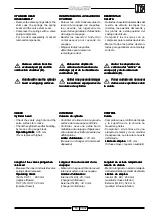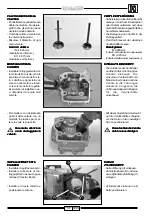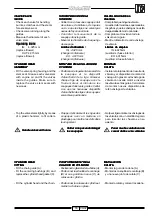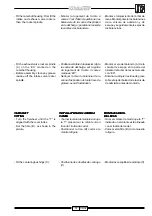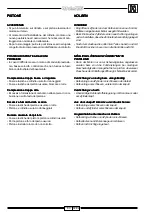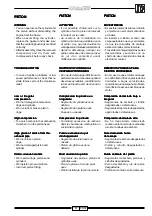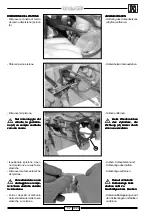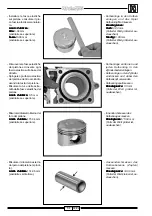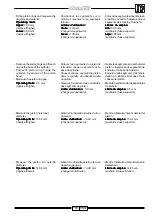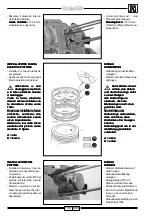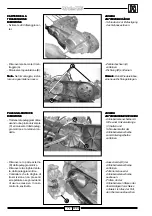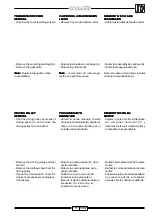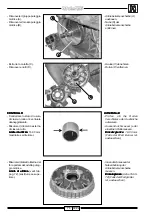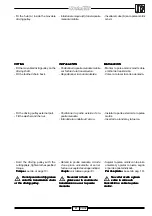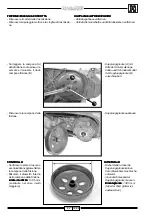
67
09/02
- Mesurer le diamètre externe du piston.
- Prendre les mesures à 9 mm du
fond et à 90° du trou de l’axe du
piston.
Limite d’utilisation :
Limite d’utilisation :
Limite d’utilisation :
Limite d’utilisation :
Limite d’utilisation : 57.90 mm
(changer si inférieure)
- Mesurer le jeu piston/axe du piston
Limite d’utilisation
Limite d’utilisation
Limite d’utilisation
Limite d’utilisation
Limite d’utilisation : 0.02 mm
(changer si supérieure).
CONTROLE DU CYLINDRE
CONTROLE DU CYLINDRE
CONTROLE DU CYLINDRE
CONTROLE DU CYLINDRE
CONTROLE DU CYLINDRE
- Contrôler l’état d’usure ou d’endom-
magement de l’alésage du cylindre.
- Mesurer le diamètre interne du
cylindre aux trois niveaux : en haut
(1), au milieu (2) en bas (3) à 90° de
l’axe du piston (dans les deux
directions X et Y).
Limite d’utilisation :
Limite d’utilisation :
Limite d’utilisation :
Limite d’utilisation :
Limite d’utilisation : 58.10 mm
(changer si inférieure).
- Mesurer le jeu piston/axe du piston.
Limite d’utilisation
Limite d’utilisation
Limite d’utilisation
Limite d’utilisation
Limite d’utilisation : 0.1 mm
(changer si supérieure).
- L’arrondi réel
L’arrondi réel
L’arrondi réel
L’arrondi réel
L’arrondi réel est la différence entre
les valeurs mesurées dans les
directions X et Y.
- La cylindricité
La cylindricité
La cylindricité
La cylindricité
La cylindricité (différence entre les
valeurs mesurées aux trois niveaux)
se rapporte à la valeur maximum
calculée.
Limite d’utilisation
Limite d’utilisation
Limite d’utilisation
Limite d’utilisation
Limite d’utilisation :
Arrondi réel
Arrondi réel
Arrondi réel
Arrondi réel
Arrondi réel :
0.05 mm
(changer si supérieure)
Cylindricité
Cylindricité
Cylindricité
Cylindricité
Cylindricité :
0.05 mm
(changer si supérieure).
- Contrôler si la sommité du cylindre
est dépourvue de déformations.
Limite d’utilisation
Limite d’utilisation
Limite d’utilisation
Limite d’utilisation
Limite d’utilisation : 0.05 mm
(changer si supérieure).
- Measure the piston outside diameter.
- Measure at 9 mm. from the bottom,
and at 90° from the piston pin hole.
Operating limits:
Operating limits:
Operating limits:
Operating limits:
Operating limits: 57.90 mm (replace
if lower)
- Measure the piston/piston pin
clearance.
Operating limits:
Operating limits:
Operating limits:
Operating limits:
Operating limits: 0.02 mm
(replace if higher).
CYLINDER CHECK
CYLINDER CHECK
CYLINDER CHECK
CYLINDER CHECK
CYLINDER CHECK
- Check the cylinder bore for wear or
damage.
- Measure the cylinder inner diameter
on three points: high (1), mean (2)
and low (3) and at 90° from the piston
pin (in both directions, X and Y).
Operating limits:
Operating limits:
Operating limits:
Operating limits:
Operating limits: 58.10 mm
(replace if lower).
- Measure piston/piston pin clearance.
Operating limits:
Operating limits:
Operating limits:
Operating limits:
Operating limits: 0.1 mm
(replace if higher).
- The real roundness
The real roundness
The real roundness
The real roundness
The real roundness results from the
difference between the values
measured in X and Y directions.
- Cylindricity
Cylindricity
Cylindricity
Cylindricity
Cylindricity (the three level value
difference) referes to the maximum
calculated value.
Operating limits:
Operating limits:
Operating limits:
Operating limits:
Operating limits:
Real roundness:
Real roundness:
Real roundness:
Real roundness:
Real roundness: 0.05 mm
(replace if higher)
Cylindricity:
Cylindricity:
Cylindricity:
Cylindricity:
Cylindricity:
0.05 mm
(replace if higher).
- Check the cylinder top for
buckling.
Operating limits:
Operating limits:
Operating limits:
Operating limits:
Operating limits: 0.05 mm
(replace if higher).
- Medir el diámetro exterior del pistón.
- La medición se efectúa a una distancia
de 9 mm. del fondo y en ángulo de 90°
respecto al ojo del perno del émbolo.
Límite de empleo:
Límite de empleo:
Límite de empleo:
Límite de empleo:
Límite de empleo: 57.90 mm
(sustituir si fuese inferior)
- Medir la holgura pistón /perno pistón
Límite de empleo:
Límite de empleo:
Límite de empleo:
Límite de empleo:
Límite de empleo: 0.02 mm
(sustituir si fuese superior).
CONTROL DEL CILINDRO
CONTROL DEL CILINDRO
CONTROL DEL CILINDRO
CONTROL DEL CILINDRO
CONTROL DEL CILINDRO
- Controlar el estado de desgaste o
deterioro de la camisa
del cilindro.
- Medir el diámetro interior del cilindro
en tres niveles diferentes: arriba (1),
mitad (2) y abajo (3) a 90° del perno
del émbolo (en ambas direcciones X
e Y).
Límite de empleo:
Límite de empleo:
Límite de empleo:
Límite de empleo:
Límite de empleo: 58.10 mm
(sustituir si fuese inferior).
- Medir la holgura pistón /perno del émbolo.
Límite de empleo:
Límite de empleo:
Límite de empleo:
Límite de empleo:
Límite de empleo: 0.1mm
(sustituir si fuese superior).
- La redondez real
La redondez real
La redondez real
La redondez real
La redondez real resulta de la
diferencia entre los valores medidos
en las direcciones X e Y.
- La cilindricidad
La cilindricidad
La cilindricidad
La cilindricidad
La cilindricidad (diferencia entre
los valores medidos en los tres
niveles) se refiere al valor máximo
calculado.
Límite de empleo:
Límite de empleo:
Límite de empleo:
Límite de empleo:
Límite de empleo:
Redondez real:
Redondez real:
Redondez real:
Redondez real:
Redondez real: 0.05 mm
(sustituir si fuese superior)
Cilindricidad:
Cilindricidad:
Cilindricidad:
Cilindricidad:
Cilindricidad:
0.05 mm
(sustituir si fuese superior).
- Comprobar que la parte superior del
cilindro no presente deformaciones.
Límite de empleo:
Límite de empleo:
Límite de empleo:
Límite de empleo:
Límite de empleo: 0.05 mm
(sustituir si fuese superior).

